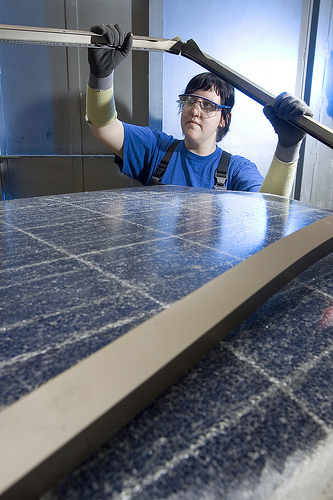 A SolarWorld worker making panels. Photo: SolarWorldAnother Silicon Valley startup is planting a tree in Portlandia’s solar forest, thanks to a United States Department of Energy loan guarantee.
A SolarWorld worker making panels. Photo: SolarWorldAnother Silicon Valley startup is planting a tree in Portlandia’s solar forest, thanks to a United States Department of Energy loan guarantee.
SoloPower, a San Jose, Calif., company that makes thin-film photovoltaic models, on Thursday snagged a $197 million federal loan guarantee to build a factory in Wilson, Ore., about 25 miles southwest of Portland.
The startup is the second Silicon Valley thin-film solar startup to make the move north over the past year. Last July, San Jose’s Solexant announced it would build a factory in Gresham east of Portland to make photovoltaic modules based on its nanocrystal technology.
Germany’s SolarWorld started blazing the Oregon solar trail in 2008 when it built the United States’ largest photovoltaic factory in Hillsboro, retooling an old semiconductor plant to make solar modules.
SoloPower will also revamp an existing industrial facility to install assembly lines. When completed, they’ll that will have the capacity to produce 400 megawatts of photovoltaic modules a year.
“The project in Wilsonville will hire hundreds of highly skilled, highly paid Oregonians to manufacture the latest in renewable energy technology”, Sen. Ron Wyden, (D-Ore.), said in a statement. “Oregon is already an epicenter for renewable energy projects.”
SoloPower is the latest Silicon Valley thin-film solar company to export manufacturing to Oregon. But the deal is most notable for the Obama administration’s gamble on a cutting-edge solar technology, one that faces challenges from Chinese competitors that have driven down the once-high cost of conventional solar modules.
While standard crystalline solar cells are made from silicon wafers, thin-film solar cells are essentially printed on flexible metal or other materials. Although such technology is less efficient at converting sunlight into electricity than crystalline silicon cells made by companies like SolarWorld, thin-film solar’s great promise is that solar cells can be made cheaper, which will lower the cost of photovoltaic power.
But the rapid expansion of low-cost manufacturers and the resulting steep plunge in photovoltaic module prices has forced Silicon Valley thin-film manufacturers to innovate faster and revamp their strategies. In November, for instance, Solyndra, which scored a $535 million federal loan guarantee to build a thin-film solar factory in Fremont, Calif., announced it would shut down an older plant and delay expansion of a new facility in an effort to lower its costs to compete against of Chinese manufacturers.
Still, the Department of Energy in December granted a $400 million to Colorado’s Abound Solar to expand production in its home state and in Indiana of an older thin-film technology called cadmium telluride.
“Investments like these are going to help America become a world leader again in clean energy manufacturing,” Energy Secretary Steven Chu said in a statement.
Now let’s see how many of those solar panels end up on Oregon roofs



